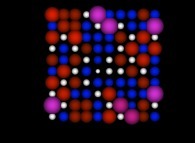
Artistic view of the prime numbers [Vue artistique des nombres premiers].

Artistic view of the prime numbers [Vue artistique des nombres premiers].
5----4----3
| | .
| | .
6 1----2 .
| |
| |
7----8----9----10
d(N) = number of divisors of N, thus
d(N) = 2 if N is a prime number (including N=1 for the sake of simplicity, when N=1 is not a prime number),
and:
f(x) = an arbitrary function, for example,
f(x) = x
Thus a first interesting picture P1 is obtained with many linear
structures made of points of the same color. For example, when
chosing:
f(2) = whiteand:
f(d) = black \-/ d#2the picture displays all the prime numbers till the number of points of the picture (in this case 512x512 = 262144). Then, it is known as the Ulam spiral.
1
z --> ---
z
the picture plane being the Complex Plane.
 The Eratosthene sieve displaying 10x10 numbers
The Eratosthene sieve displaying 10x10 numbers
 The Eratosthene sieve displaying 100x100 numbers
The Eratosthene sieve displaying 100x100 numbers
 The generalized Ulam spiral displaying 100 numbers
The generalized Ulam spiral displaying 100 numbers
 The generalized Ulam spiral displaying 1024 numbers
The generalized Ulam spiral displaying 1024 numbers
 An Archimedes spiral displaying 100 numbers
An Archimedes spiral displaying 100 numbers
 An Archimedes spiral displaying 1000 numbers
An Archimedes spiral displaying 1000 numbers